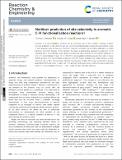Multitask prediction of site selectivity in aromatic C-H functionalization reactions
Author(s)
Struble, Thomas J; Coley, Connor Wilson; Jensen, Klavs F
Downloadd0re00071j.pdf (1.833Mb)
Publisher with Creative Commons License
Publisher with Creative Commons License
Creative Commons Attribution
Terms of use
Metadata
Show full item recordAbstract
Aromatic C–H functionalization reactions are an important part of the synthetic chemistry toolbox. Accurate prediction of site selectivity can be crucial for prioritizing target compounds and synthetic routes in both drug discovery and process chemistry. However, selectivity may be highly dependent on subtle electronic and steric features of the substrate. We report a generalizable approach to prediction of site selectivity that is accomplished using a graph-convolutional neural network for the multitask prediction of 123 C–H functionalization tasks. In an 80/10/10 training/validation/testing pseudo-time split of about 58 000 aromatic C–H functionalization reactions from the Reaxys database, the model achieves a mean reciprocal rank of 92%. Once trained, inference requires approximately 200 ms per compound to provide quantitative likelihood scores for each task. This approach and model allow a chemist to quickly determine which C–H functionalization reactions – if any – might proceed with high selectivity.
Date issued
2020-04Department
Massachusetts Institute of Technology. Department of Chemical EngineeringJournal
Reaction Chemistry & Engineering
Citation
Struble, Thomas J., Connor Wilson Coley, and Klavs F. Jensen, "Multitask prediction of site selectivity in aromatic C-H functionalization reactions." Reaction Chemistry & Engineering 5 (Apr. 2020): no. 896 doi 10.1039/D0RE00071J ©2020 Author(s)
Version: Final published version
ISSN
2058-9883